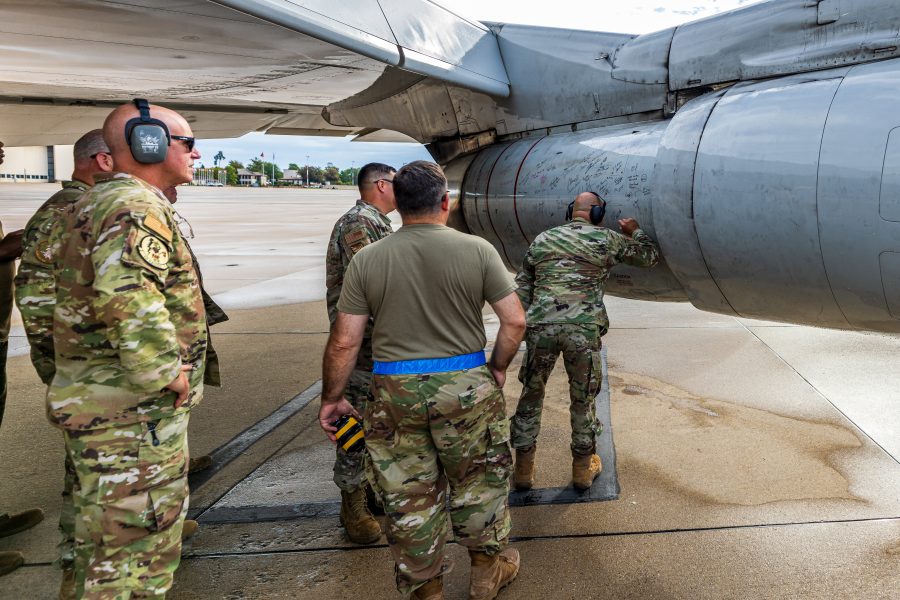A crew of Airmen at Ramstein Air Base, Germany, flew the final operational sortie of the E-8C JSTARS aircraft on Sept. 21, paving the way for the last of the fleet to be retired early next month.
Members of the Georgia Air National Guard’s 116th Air Control Wing flew the very last of more than 14,000 sorties for the JSTARS, which is used for targeting, battle management, and command and control.
“It’s bittersweet,” Col. Christopher Dunlap, commander of the 116th Air Control Wing, said in a release. “I’ve been flying this mission on this aircraft since the spring of 2003. There’s been a lot of changes over the years.”
A spokesman for the 116th ACW told Air & Space Forces Magazine that two JSTARS aircraft now remain at Robins Air Force Base, Ga. The tentative plan is to send the last one to the “Boneyard” at Davis-Monthan Air Force Base, Ariz., in the first week of November.
Until then, “the aircraft may be used locally for aircrew proficiency training as needed,” the spokesman added.
Still, the final operational sorties mark one of the final milestones for the E-8. Primarily used for ground moving target indication, JSTARS also served as a battle management platform. Its most distinctive feature is the 27-foot long, canoe-shaped radome under the forward fuselage that houses a 24-foot long, side-looking phased array antenna.
The aircraft first supported combat operations during Desert Storm and played a key role in the Air Force’s contributions during the Global War on Terror. More recently, the E-8 flew missions over Eastern Europe in the run-up and immediate aftermath of Russia’s 2022 invasion of Ukraine.
The Air Force has been planning to move on from JSTARS for a while. In June 2021, service leaders announced their intent to cut the aircraft from Robins, which has hosted them since 1996.
In its place, Robins is getting a Battle Management Control squadron, an E-11A Battlefield Airborne Communication Node (BACN) squadron, a Spectrum Warfare group, and support units focused on the service’s Advanced Battle Management System (ABMS).
The first E-8 departed Robins in February 2022. A month later, the service announced its intent to divest 12 of 16 aircraft in fiscal 2023 and 2024, and Congress expedited the move by repealing a previous law requiring the Air Force to maintain at least six E-8s.
This past March, the Air Force budget request revealed a plan to accelerate the divestment plan, with the entire fleet retiring by the end of fiscal 2024, which started Oct. 1.
Service leaders have said the Air Force needs to retire JSTARS because it would not survive in a future fight with an advanced adversary like China. Instead, they want to invest in various information and targeting technologies, including space-based platforms.
Over the last several months, Robins has wound down JSTARS operations, deactivating squadrons and conducting final flights. In June, the Active-Duty 461st Air Control Wing completed its last operational mission at Ramstein.
The 116th ACW spokesman said before the final aircraft is officially retired, there will be “a private farewell celebration for alumni of the JSTARS program.”
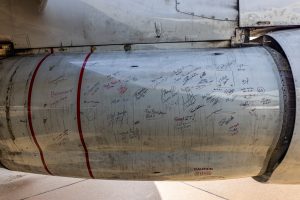
U.S. Airmen signatures on an E-8C Joint STARS aircraft engine as it sits on the flightline at Ramstein Air Force Base, Germany, Sept. 21, 2023. The JSTARS have been in service since 2002. (U.S. Air National Guard photo by Master Sgt. Jeff Rice)

U.S. Air Force Capt. Andrea Coleman and 2nd Lt. Travis Trent, pilots with the 116th Air Control Wing, Georgia Air National Guard, give the thumbs up on an E-8C Joint STARS during its last mission at Ramstein Air Force Base, Germany, Sept. 21, 2023. The JSTARS have been in service since 2002. (U.S. Air National Guard photo by Master Sgt. Jeff Rice)

U.S. Airmen with the 116th Air Control Wing, Georgia Air National Guard, sign an engine of an E-8C Joint STARS for its last mission at Ramstein Air Force Base, Germany, Sept. 21, 2023. The JSTARS have been in service since 2002. (U.S. Air National Guard photo by Master Sgt. Jeff Rice)

U.S. Airmen with the 116th Air Control Wing, Georgia Air National Guard, sign an engine of an E-8C Joint STARS for its last mission at Ramstein Air Force Base, Germany, Sept. 21, 2023. The JSTARS have been in service since 2002. (U.S. Air National Guard photo by Master Sgt. Jeff Rice)
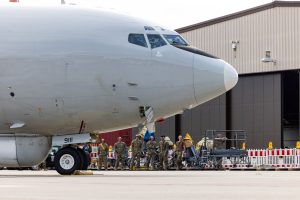
U.S. Airmen with the 116th Air Control Wing, Georgia Air National Guard, watch an E-8C Joint STARS taxi for its last mission at Ramstein Air Force Base, Germany, Sept. 21, 2023. The JSTARS have been in service since 2002. (U.S. Air National Guard photo by Master Sgt. Jeff Rice)
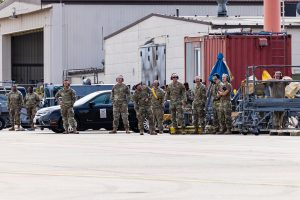
U.S. Airmen with the 116th Air Control Wing, Georgia Air National Guard, watch an E-8C Joint STARS taxi for its last mission at Ramstein Air Force Base, Germany, Sept. 21, 2023. The JSTARS have been in service since 2002. (U.S. Air National Guard photo by Master Sgt. Jeff Rice)

An E-8C Joint STARS aircraft taxis on the flightline at Ramstein Air Force Base, Germany, Sept. 21, 2023. The JSTARS have been in service since 2002. (U.S. Air National Guard photo by Master Sgt. Jeff Rice)
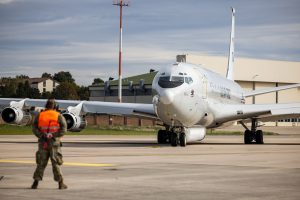
An E-8C Joint STARS aircraft taxis on the flightline at Ramstein Air Force Base, Germany, Sept. 21, 2023. The JSTARS have been in service since 2002. (U.S. Air National Guard photo by Master Sgt. Jeff Rice)

An E-8C Joint STARS aircraft taxis on the flightline at Ramstein Air Force Base, Germany, Sept. 21, 2023. The JSTARS have been in service since 2002. (U.S. Air National Guard photo by Master Sgt. Jeff Rice)
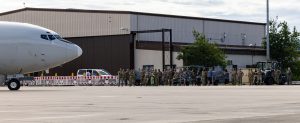
U.S. Airmen with the 116th Air Control Wing, Georgia Air National Guard, watch an E-8C Joint STARS taxi for its last mission at Ramstein Air Force Base, Germany, Sept. 21, 2023. The JSTARS have been in service since 2002. (U.S. Air National Guard photo by Master Sgt. Jeff Rice)

U.S. Air Force Capt. Andrea Coleman, a pilot with the 116th Air Control Wing, Georgia Air National Guard, waves from an E-8C Joint STARS during its last mission at Ramstein Air Force Base, Germany, Sept. 21, 2023. The JSTARS have been in service since 2002. (U.S. Air National Guard photo by Master Sgt. Jeff Rice)
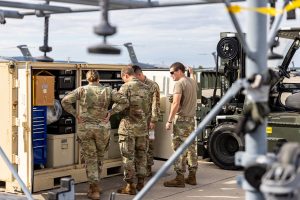
U.S. Airmen with the 116th Air Control Wing, Georgia Air National Guard, pack up gear one last time in preperation to leave from Ramstein Air Force Base, Germany, Sept. 21, 2023. This JSTARS have been in service since 2002. (U.S. Air National Guard photo by Master Sgt. Jeff Rice)
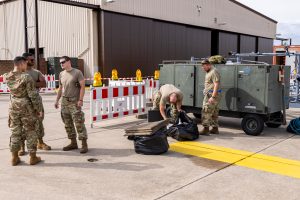
U.S. Airmen with the 116th Air Control Wing, Georgia Air National Guard, pack up gear one last time in preperation to leave from Ramstein Air Force Base, Germany, Sept. 21, 2023. This JSTARS have been in service since 2002. (U.S. Air National Guard photo by Master Sgt. Jeff Rice)
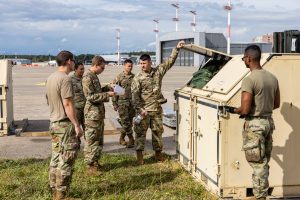
U.S. Airmen with the 116th Air Control Wing, Georgia Air National Guard, pack up gear one last time in preperation to leave from Ramstein Air Force Base, Germany, Sept. 21, 2023. This JSTARS have been in service since 2002. (U.S. Air National Guard photo by Master Sgt. Jeff Rice)
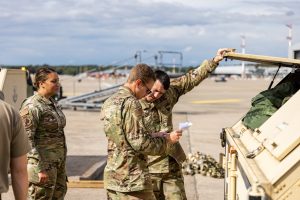
U.S. Airmen with the 116th Air Control Wing, Georgia Air National Guard, pack up gear one last time in preperation to leave from Ramstein Air Force Base, Germany, Sept. 21, 2023. This JSTARS have been in service since 2002. (U.S. Air National Guard photo by Master Sgt. Jeff Rice)

U.S. Airmen with the 116th Air Control Wing, Georgia Air National Guard, pack up gear one last time in preperation to leave from Ramstein Air Force Base, Germany, Sept. 21, 2023. This JSTARS have been in service since 2002. (U.S. Air National Guard photo by Master Sgt. Jeff Rice)
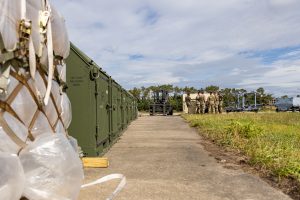
U.S. Airmen with the 116th Air Control Wing, Georgia Air National Guard, pack up gear one last time in preperation to leave from Ramstein Air Force Base, Germany, Sept. 21, 2023. This JSTARS have been in service since 2002. (U.S. Air National Guard photo by Master Sgt. Jeff Rice)
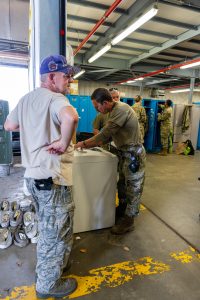
U.S. Airmen with the 116th Air Control Wing, Georgia Air National Guard, pack up gear one last time in preperation to leave from Ramstein Air Force Base, Germany, Sept. 21, 2023. This JSTARS have been in service since 2002. (U.S. Air National Guard photo by Master Sgt. Jeff Rice)
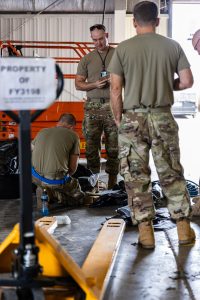
U.S. Airmen with the 116th Air Control Wing, Georgia Air National Guard, pack up gear one last time in preperation to leave from Ramstein Air Force Base, Germany, Sept. 21, 2023. This JSTARS have been in service since 2002. (U.S. Air National Guard photo by Master Sgt. Jeff Rice)
